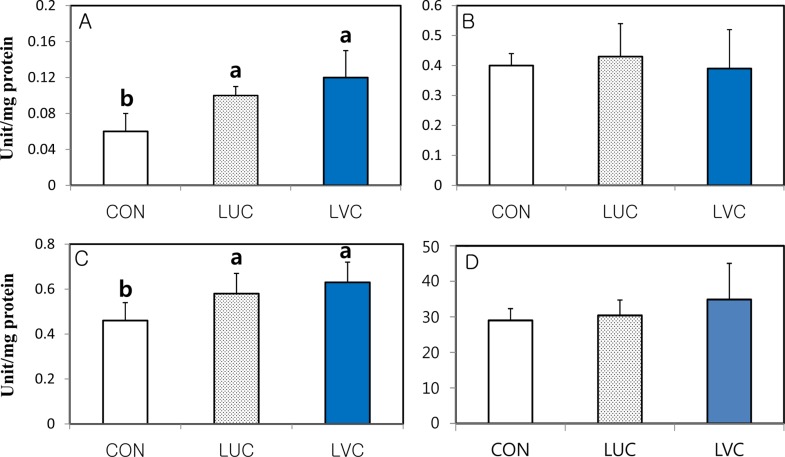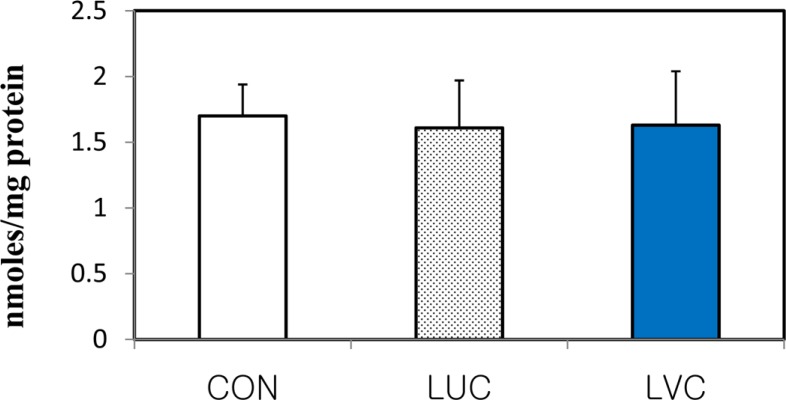Lab Anim Res.
2015 Sep;31(3):117-124. 10.5625/lar.2015.31.3.117.
Effects of lutein or lutein in combination with vitamin C on mRNA expression and activity of antioxidant enzymes and status of the antioxidant system in SD rats
- Affiliations
-
- 1Department of Animal Science and Biotechnology and the Regional Animal Research Center, Gyeongnam National University of Science and Technology, Jinju, Korea. isjang@gntech.ac.kr
- 2Department of Food Science, Gyeongnam National University of Science and Technology, Jinju, Korea.
- 3Department of Biomaterials Science, College of Natural Resources & Life Science/Life and Industry Convergence Research Institute, Pusan National University, Miryang, Korea.
- KMID: 2312128
- DOI: http://doi.org/10.5625/lar.2015.31.3.117
Abstract
- This study was conducted to investigate the effects of lutein alone or in combination with vitamin C on the antioxidant defense system in rats. A total of 18 eight-week-old male Sprague Dawley (SD) rats were randomly assigned to three groups for 4 weeks: control (CON), lutein (LUT, 50 mg lutein/kg BW) and lutein plus vitamin C (LVC, 50 mg lutein/kg BW+1,000 mg vitamin C/kg BW). No differences in body weight, relative live weight or plasma biochemical profiles were observed among treatment groups. In the hepatic antioxidant defense systems, the mRNA expression of superoxide dismutase (SOD) in the LUT and LVC groups was significantly (P<0.05) higher than that in the CON group, whereas the mRNA level of glutathione peroxidase (GPX), catalase (CAT) and glutathione S-transferase (GST) was not affected by the administration of antioxidants. SOD and GST activities in the LUT and LVC groups were significantly higher (P<0.05) than those in the CON group, whereas GPX, CAT and lipid peroxidation did not differ among groups. In addition, the LVC group showed a significant (P<0.05) increase in plasma and hepatic total antioxidant power (TAP) relative to the CON group. Overall, administration of lutein in combination with vitamin C improved the status of the total antioxidant defense system in SD rats.
Keyword
MeSH Terms
-
Animals
Antioxidants
Ascorbic Acid*
Body Weight
Catalase
Cats
Glutathione Peroxidase
Glutathione Transferase
Humans
Lipid Peroxidation
Lutein*
Male
Plasma
Rats*
RNA, Messenger*
Superoxide Dismutase
Vitamins*
Antioxidants
Ascorbic Acid
Catalase
Glutathione Peroxidase
Glutathione Transferase
Lutein
RNA, Messenger
Superoxide Dismutase
Vitamins
Figure
Reference
-
1. Berendschot TT, Goldbohm RA, Klöpping WA, van de Kraats J, van Norel J, van Norren D. Influence of lutein supplementation on macular pigment, assessed with two objective techniques. Invest Ophthalmol Vis Sci. 2000; 41(11):3322–3326. PMID: 11006220.2. Ahmed SS, Lott MN, Marcus DM. The macular xanthophylls. Surv Ophthalmol. 2005; 50(2):183–193.
Article3. Alves-Rodrigues A, Shao A. The science behind lutein. Toxicol Lett. 2004; 150(1):57–83. PMID: 15068825.
Article4. Bone RA, Landrum JT, Cains A. Optical density spectra of the macular pigment in vivo and in vitro. Vision Res. 1992; 32(1):105–110. PMID: 1502795.5. Lim BP, Nagao A, Terao J, Tanaka K, Suzuki T, Takama K. Antioxidant activity of xanthophylls on peroxyl radical-mediated phospholipid peroxidation. Biochim Biophys Acta. 1992; 1126(2):178–184. PMID: 1627620.6. Wang M, Tsao R, Zhang S, Dong Z, Yang R, Gong J, Pei Y. Antioxidant activity, mutagenicity/anti-mutagenicity, and clastogenicity/anti-clastogenicity of lutein from marigold flowers. Food Chem Toxicol. 2006; 44(9):1522–1529. PMID: 16757077.
Article7. Bartlett HE, Eperjesi F. Effect of lutein and antioxidant dietary supplementation on contrast sensitivity in age-related macular disease: a randomized controlled trial. Eur J Clin Nutr. 2007; 61(9):1121–1127. PMID: 17268417.
Article8. Leeson S, Caston L. Enrichment of eggs with lutein. Poult Sci. 2004; 83(10):1709–1712. PMID: 15510557.
Article9. Mamatha BS, Baskaran V. Effect of micellar lipids, dietary fiber and β-carotene on lutein bioavailability in aged rats with lutein deficiency. Nutrition. 2011; 27(9):960–966. PMID: 21295945.
Article10. Lakshminarayana R, Raju M, Keshava Prakash MN, Baskaran V. Phospholipid, oleic acid micelles and dietary olive oil influence the lutein absorption and activity of antioxidant enzymes in rats. Lipids. 2009; 44(9):799–806. PMID: 19685091.
Article11. Shanmugasundaram R, Selvaraj RK. Lutein supplementation alters inflammatory cytokine production and antioxidant status in F-line turkeys. Poult Sci. 2011; 90(5):971–976. PMID: 21489941.
Article12. Blakely S, Herbert A, Collins M, Jenkins M, Mitchell G, Grundel E, O'Neill KR, Khachik F. Lutein interacts with ascorbic acid more frequently than with alpha-tocopherol to alter biomarkers of oxidative stress in female zucker obese rats. J Nutr. 2003; 133(9):2838–2844. PMID: 12949374.13. Tauler P, Aguiló A, Fuentespina E, Tur JA, Pons A. Diet supplementation with vitamin E, vitamin C and beta-carotene cocktail enhances basal neutrophil antioxidant enzymes in athletes. Pflugers Arch. 2002; 443(5-6):791–797. PMID: 11889577.14. Taylor A, Jacques PF, Chylack LT Jr, Hankinson SE, Khu PM, Rogers G, Friend J, Tung W, Wolfe JK, Padhye N, Willett WC. Long-term intake of vitamins and carotenoids and odds of early age-related cortical and posterior subcapsular lens opacities. Am J Clin Nutr. 2002; 75(3):540–549. PMID: 11864861.
Article15. Reboul E, Thap S, Tourniaire F, Andre M, Juhel C, Morange S, Amiot MJ, Lairon D, Borel P. Differential effect of dietary antioxidant classes (carotenoids, polyphenols, vitamins C and E) on lutein absorption. Br J Nutr. 2007; 97(3):440–446. PMID: 17313704.
Article16. Livak KJ, Schmittgen TD. Analysis of relative gene expression data using real-time quantitative PCR and the 2(-Delta Delta C(T)) Method. Methods. 2001; 25(4):402–408. PMID: 11846609.17. Fridovich I. Superoxide dismutase. Enzymology. 1974; 41:36–40.
Article18. Tappel AL. Glutathione peroxidase and hydroperoxides. Methods Enzymol. 1978; 52:506–513. PMID: 672654.19. Habig WH, Pabst MJ, Jakoby WB. Glutathione S-transferases. The first enzymatic step in mercapturic acid formation. J Biol Chem. 1974; 249(22):7130–7139. PMID: 4436300.20. Bidlack WR, Tappel AL. Damage to microsomal membrane by lipid peroxidation. Lipids. 1973; 8(4):177–182. PMID: 4348615.
Article21. Giannini E, Botta F, Fasoli A, Ceppa P, Risso D, Lantieri PB, Celle G, Testa R. Progressive liver functional impairment is associated with an increase in AST/ALT ratio. Dig Dis Sci. 1999; 44(6):1249–1253. PMID: 10389705.22. Kim JE, Clark RM, Park Y, Lee J, Fernandez ML. Lutein decreases oxidative stress and inflammation in liver and eyes of guinea pigs fed a hypercholesterolemic diet. Nutr Res Pract. 2012; 6(2):113–119. PMID: 22586499.
Article23. Bhattacharyya S, Datta S, Mallick B, Dhar P, Ghosh S. Lutein content and in vitro antioxidant activity of different cultivars of Indian marigold flower (Tagetes patula L.) extracts. J Agric Food Chem. 2010; 58(14):8259–8264. PMID: 20568770.
Article24. Hayes JE, Stepanyan V, Allen P, O'Grady MN, O'Brien NM, Kerry JP. The effect of lutein, sesamol, ellagic acid and olive leaf extract on lipid oxidation and oxymyoglobin oxidation in bovine and porcine muscle model systems. Meat Sci. 2009; 83(2):201–208. PMID: 20416759.
Article25. Sindhu ER, Preethi KC, Kuttan R. Antioxidant activity of carotenoid lutein in vitro and in vivo. Indian J Exp Biol. 2010; 48(8):843–848. PMID: 21341544.26. Serpeloni JM, Colus IM, de Oliveira FS, Aissa AF, Mercadante AZ, Bianchi ML, Antunes LM. Diet carotenoid lutein modulates the expression of genes related to oxygen transporters and decreases DNA damage and oxidative stress in mice. Food Chem Toxicol. 2014; 70:205–213. PMID: 24865317.
Article27. Jewell C, O'Brien NM. Effect of dietary supplementation with carotenoids on xenobiotic metabolizing enzymes in the liver, lung, kidney and small intestine of the rat. Br J Nutr. 1999; 81(3):235–242. PMID: 10434850.
Article28. Hininger IA, Meyer-Wenger A, Moser U, Wright A, Southon S, Thurnham D, Chopra M, Van Den Berg H, Olmedilla B, Favier AE, Roussel AM. No significant effects of lutein, lycopene or beta-carotene supplementation on biological markers of oxidative stress and LDL oxidizability in healthy adult subjects. J Am Coll Nutr. 2001; 20(3):232–238. PMID: 11444419.29. Wang S, Wang M, Zhang S, Zhao L. Oxidative stress in rats with hyperhomo-cysteinemia and intervention effect of lutein. Eur Rev Med Pharmacol Sci. 2014; 18(3):359–364. PMID: 24563435.30. Arnal E, Miranda M, Barcia J, Bosch-Morell F, Romero FJ. Lutein and docosahexaenoic acid prevent cortex lipid peroxidation in streptozotocin-induced diabetic rat cerebral cortex. Neuroscience. 2010; 166(1):271–278. PMID: 20036322.
Article31. Sindhu ER, Firdous AP, Preethi KC, Kuttan R. Carotenoid lutein protects rats from paracetamol-, carbon tetrachloride- and ethanol-induced hepatic damage. J Pharm Pharmacol. 2010; 62(8):1054–1060. PMID: 20663040.
Article32. Yun SH, Moon YS, Sohn SH, Jang IS. Effects of cyclic heat stress or vitamin C supplementation during cyclic heat stress on HSP70, inflammatory cytokines, and the antioxidant defense system in Sprague Dawley rats. Exp Anim. 2012; 61(5):543–553. PMID: 23095818.
Article33. Mustacich DJ, Bruno RS, Traber MG. Vitamin E. Vitam Horm. 2007; 76:1–21. PMID: 17628169.
Article34. Traber MG, Atkinson J. Vitamin E, antioxidant and nothing more. Free Radic Biol Med. 2007; 43(1):4–15. PMID: 17561088.
Article35. Sen A, Marsche G, Freudenberger P, Schallert M, Toeglhofer AM, Nagl C, Schmidt R, Launer LJ, Schmidt H. Association between higher plasma lutein, zeaxanthin, and vitamin C concentrations and longer telomere length: results of the Austrian Stroke Prevention Study. J Am Geriatr Soc. 2014; 62(2):222–229. PMID: 24428184.
Article
- Full Text Links
- Actions
-
Cited
- CITED
-
- Close
- Share
- Similar articles
-
- Effect of Lutein on L-NAME-Induced Hypertensive Rats
- Lutein decreases oxidative stress and inflammation in liver and eyes of guinea pigs fed a hypercholesterolemic diet
- Self-Nanoemulsifying Drug Delivery System of Lutein: Physicochemical Properties and Effect on Bioavailability of Warfarin
- The effects of coenzyme Qâ‚â‚€ supplement on blood lipid indices and hepatic antioxidant defense system in SD rats fed a high cholesterol diet
- Antioxidant System and Oxidative Stress in Uterine Cervical Neoplasia of Korean women




